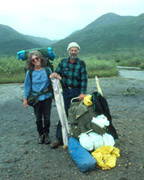Arctic Grayling Still Thrive in Isolated Montana Lakes

Arctic Grayling Schooling
©Bert Gildart: The last congregations of spring-spawning grayling have just about completed their mission, as Tom Ulrich, a photographer friend (with world photo coverage), and I recently discovered.
This past week Tom and I made the one-hour drive from Kalispell to Roger’s Lake and found this small group of Arctic Grayling. The sight was fascinating, and we watched as several individuals attempted to fling themselves up and over a small but substantial log jam. They have a mission and that is to perpetuate their kind, and do so in spring by broadcasting their eggs over gravel bottoms in moving streams.
Once the species was found throughout Michigan and Montana, but the Michigan population is now extinct. In Montana, the species is found in the upper Big Hole River (not too far from Yellowstone National Park) and in about 30 or more lakes in the western half of Montana. In the Flathead Valley, Roger’s Lake is one such area.
When discovered by Lewis and Clark the explorers noted the species as a “new kind of white or silvery trout.” The species, as I’ve learned from various fishing expeditions, is readily identified by its huge dorsal fin, and in the right kind of light can appear silver and almost iridescent. This species is, in fact, a member of the family Salmonidae, which does include both salmon and trout. Experience has shown me grayling are gullible, and at times easy to catch, particularly on silver Mepps lures.
Though I’ve caught Arctic grayling in Glacier National Park, I am most familiar with the species from a month-long backpack trip Janie and I made through the Arctic National Wildlife Refuge. Stopping for the evening by a small stream feeding into the Chandalar River on the south side of the Brooks Range, we began fishing for anything that would take our lure, but were instantly rewarded when a huge grayling took our bait. Now, we had the beginning of supper, for this fish was large, reaching its maximum length of 20 inches. It was full bellied, and probably weighed several pounds.
Enthusiastic now, we continued fishing and immediately landed another, which we also kept. Then—and I have never in my life had such luck—we continued landing grayling, after grayling after grayling. These, however, we returned to the Chandalar.

Author and Arctic Grayling School
For Tom and me, the dense populations we saw last week at Roger’s Lake made wonderful photographic subjects, and we worked hard for several hours trying with our images to show just how dense these spring spawning populations could be. Unlike salmon, they don’t die after releasing egg and milt, rather they return to the lake and live to spawn again.
Because their habitat and numbers have so drastically declined, many believe the species should be protected, but last month the U.S. Fish and Wildlife Service ruled the grayling did not deserve federal protection, although the agency since 1994 had maintained the fish was in trouble and deserved listing. The reversal was due to political pressure from the Bush administration, according to those who declared their intent to sue.
They blame Julie MacDonald, former deputy assistant secretary of the Interior, who recently resigned after accusations that she interfered with government scientists and leaked sensitive information to industry groups fighting the listing of different species.
Politics aside, the sight of all these grayling was one of the high points of the past week, not only because of the photographic opportunities, but because of the wonderful memories the experience evoked.

